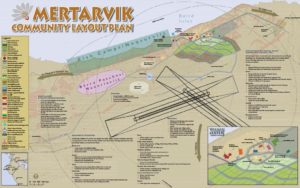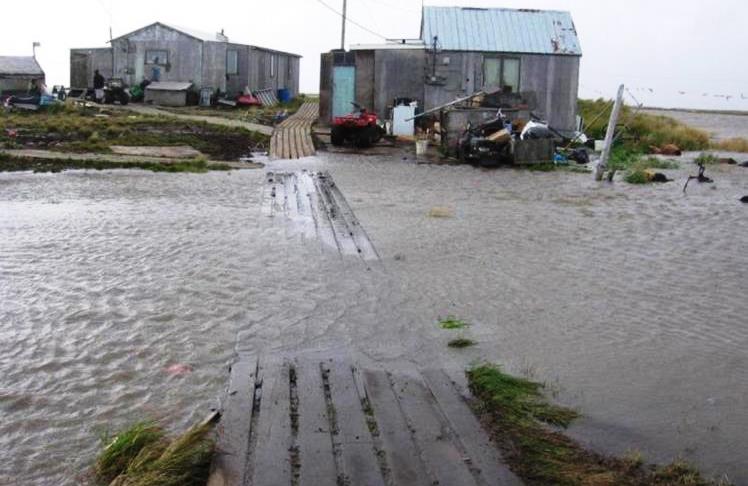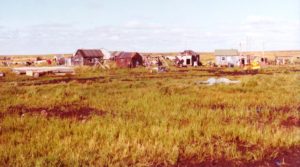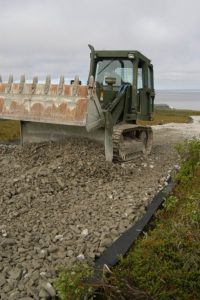Newtok (Niugtaq in the Central Alaskan Yup’ik language) is a small village on the Ningliq River on the Bering Sea coast of Alaska. The 2010 census found a population of 354.
 Erosion from rising sea levels and melting permafrost (no longer permanently frozen) is forcing the primarily Yupik Alaska Native village to relocate to a neighboring village.
Erosion from rising sea levels and melting permafrost (no longer permanently frozen) is forcing the primarily Yupik Alaska Native village to relocate to a neighboring village.
The school, which sits perched atop 20-foot pilings, will likely be underwater by the end of this year.
The Newtok Planning Group was formed in May 2006 when representatives from state and federal agencies and non-governmental organizations began meeting with Newtok to coordinate assistance for the relocation of the community to a new village site on Nelson Island.
On August 10, 2017—after over a decade of planning—a ribbon-cutting was held at the new village site in Mertarvik, which ironically means “a place for water.”
 The new community is safely above the encroaching water that’s destroying Newtok. “It’s a safe land; it’s high… it’s beautiful,” said Albertina Charles, a lifelong Newtok resident who is thrilled to be there.
The new community is safely above the encroaching water that’s destroying Newtok. “It’s a safe land; it’s high… it’s beautiful,” said Albertina Charles, a lifelong Newtok resident who is thrilled to be there.
Still under construction is the Mertarvik Evacuation Center, which the community hopes to start using next year. The two-room building is being built large enough to house 250 people, if need be.
A little ways further up the hillside is the dining hall that Troy Welch from HC Contractors helped build. “It’s gonna be a viable community, very viable. It’s gonna be the community center, the kitchen area. I think it’s gonna be the heart of the community,” said Welch.
Planners are still working to secure the rest of the funding for the building and much of the planned housing.
Despite this joy and optimism, the move has, of course, been both traumatic and fraught with difficulties.
In 2013, for instance, the village’s relocation effort broke down due to an internal political conflict, and a freeze on government funding.
The rising tensions fed a rebellion against the village leadership, the Newtok Traditional Council, which had run the village for seven years without facing an election.Also pilloried was the administrator overseeing the relocation effort, Stanley Tom. His critics said he had botched the move to Mertarvik, and neglected the existing village.
In July of 2013, the Bureau of Indian Affairs (BIA) took the unusual step of intervening in the internal dispute.
They ruled the old council – which was working closely with Tom – no longer represented the villagers of Newtok.
The long stand-off has cost the village several months in its efforts to relocate, but—though there is much more to be done—there is now solid progress.
 The biggest uncertainty threatening continued progress at Mertarvik is what kind of federal funding will be available.
The biggest uncertainty threatening continued progress at Mertarvik is what kind of federal funding will be available.
Bureau of Indian Affairs Acting Director Lynn Polacca says that Newtok is only one of many villages at risk from climate change.
The BIA, he says, is able to help fund roads, but does not have as much money available for housing.
All photos and images courtesy of the government of Alaska, unless otherwise credited, including the featured photo, which shows a 2005 Newtok flood.
See KDLG article by Christine Trudeau.
See Alaskan government web page on Newtok relocation.



